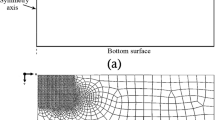Abstract
As the mathematical model has been developed in part I, the simulation results of the transport phenomena and solidification cracking in laser spot bead-on-plate welding of AA6063-T6 aluminum alloy and the experimental validation are presented in this paper. Modeling results showed that the solute concentration in the solidified region continuously increases during the solidification process. As the temperature is lower than the coherent temperature (i.e., the temperature at which the coherent mushy zone is just formed), the strains accumulated in the coherent mushy zone increase with the increasing solid fraction. The amount of strain in the mushy zone is primarily determined by the life (i.e., time span) of the coherent mushy zone, which is determined by the solidification range and solidification time. The increased solidification range and consequently solidification time extend the life of the coherent mushy zone, which increases the amount of strain and thus increases the likelihood of solidification cracking. The modeling results are in agreement with the experimental results. Both the experimental and modeling results exhibited that solidification cracking is prone to occurring near the top surface and middle part of the weld bead and an increase of laser power leads to the higher cracking susceptibility.
Similar content being viewed by others
References
Liu JW, Rao ZH, Liao SM, Wang PC (2014) Modeling of transport phenomena and solidification cracking in laser spot bead-on-plate welding of AA6063-T6 alloy. Part I–The mathematical model. Int J Adv Manuf Technol. doi:10.1007/s00170-014-5924-2
Mazumder J (1990) Laser–beam welding. In: ASM handbook, volume 6, welding, brazing, and soldering. ASM International, pp. 262–269
Kawahito Y, Mizutani M, Katayama S (2007) Elucidation of high-power fiber laser welding phenomena of stainless steel and effect of factors on weld geometry. J Phys D Appl Phys 40:5854–5859
Pastor M, Zhao H, Martukanitz RP, DebRoy T (1999) Porosity, underfill and magnesium lose during continuous wave Nd: YAG laser welding of thin plates of aluminum alloys 5182 and 5754. Weld J 78:207s–216s
Zhao H, White DR, DebRoy T (1999) Current issues and problems in laser welding of automotive aluminum alloys. Int Mater Rev 44:238–266
Kou S (2003) Solidification and liquation cracking issues in welding. JOM 55:37–42
Cross CE (2005) On the origin of weld solidification cracking. In: Böllinghaus T, Herolded H (eds) Hot cracking phenomena in welds, volume 1. Springer
Pumphrey WI, Jennings PH (1948) A consideration of the nature of brittleness and temperature above the solidus in castings and welds in aluminum alloys. J Inst Met 75:235–256
Pellini WS (1952) Strain theory of hot tearing. Foundry 80:125–199
Feurer U (1977) Quality control of engineering alloys and the role of metals science. Delft University of Technology, Delft, pp 131–145
Clyne TW, Davies GJ (1979) Comparison between experimental data and theoretical predictions relating to dependence of solidification cracking on composition. In: Solidification and casting of metals. Metals Society, London, 275–278
Katgerman L (1982) A mathematical model for hot cracking of aluminum alloys during DC casting. JOM 34:46–49
Prokhorov NN (1962) Resistance to hot tearing of cast metals during solidification. Russ Castings Prod 2:172–175
Magnin B, Katgerman L, Hannart B (1995) Physical and numerical modelling of thermal stress generation during DC casting of aluminium alloys. In: Cross M., Campbell J (eds) Modeling of casting welding and advanced solidification processes VII. Warrendale, PA, pp. 303–310
Braccini M, Martin CL, Suéry M (2000) Relation between the mushy zone rheology and hot tearing phenomena in Al-Cu alloys. In: Sahm PR, Hansen PN, Conley JG (eds) Modeling of casting welding and advanced solidification processes IX. Shaker Verlag, Aachen, pp 18–24
Rappaz M, Drezet JM, Gremaud M (1999) A new hot-tearing criterion. Metall Mater Trans A 30:449–455
Suyitno, Kool WH, Katgerman L (2005) Hot tearing criteria evaluation for direct-chill casting of an Al-4.5 Pct Cu alloy. Metall Mater Trans A 36A:1537–1546
Cicală E, Duffetb G, Andrzejewski H, Grevey D, Ignata S (2005) Hot cracking in Al–Mg–Si alloy laser welding–operating parameters and their effects. Mater Sci Eng A 395:1–9
Kim HT, Nam SW, Hwang SH (1996) Study on the solidification cracking behavior of high strength aluminum alloy welds: effects of alloying elements and solidification behaviors. J Mater Sci 31:2859–2864
Ploshikhin V, Zoch HW (2005) Integrated mechanical-metallurgical approach to modeling of solidification cracking in welds. Hot Crack Phenom Welds 223–244
Karunakar DB, Rai RN, Patra S, Datta GL (2009) Effects of grain refinement and residual elements on hot tearing in aluminum castings. Int J Adv Manuf Technol 45:851–858
Ploshikhin V, Prikhodovsky A, Ilin A, Makhutin M, Heimerdinger C, Palm F (2006) Influence of the weld metal chemical composition on the solidification cracking susceptibility of AA6056-T4 alloy. Weld World 50:46–50
Yang YP, Dong P, Zhang J, Tian X (2000) A hot-cracking mitigation technique for welding high-strength aluminum alloy. Weld J 79:9–17
Hu B, Richardson IM (2006) Mechanism and possible solution for transverse solidification cracking in laser welding of high strength aluminum alloy. Mater Sci Eng A 429:287–294
Chen W, Molian P (2008) Dual-beam laser welding of ultra-thin AA 5052-H19 aluminum. Int J Adv Manuf Technol 39:889–897
Zhang J, Weckman DC, Zhou Y (2008) Effects of temporal pulse shaping on cracking susceptibility of 6061-T6 aluminum Nd:YAG laser welds. Weld J 87:18–30
Lakshminarayanan AK, Balasubramanian V, Elangovan K (2009) Effect of welding processes on tensile properties of AA6061 aluminium alloy joints. Int J Adv Manuf Technol 40:286–296
Davis JR (2010) ASM handbook vol. 02, properties and selection: nonferrous alloys and special-purpose materials, 10th edn. ASM International, Materials Park
Author information
Authors and Affiliations
Corresponding author
Rights and permissions
About this article
Cite this article
Liu, J., Rao, Z., Liao, S. et al. Modeling of transport phenomena and solidification cracking in laser spot bead-on-plate welding of AA6063-T6 alloy. Part II—simulation results and experimental validation. Int J Adv Manuf Technol 74, 285–296 (2014). https://doi.org/10.1007/s00170-014-5935-z
Received:
Accepted:
Published:
Issue Date:
DOI: https://doi.org/10.1007/s00170-014-5935-z




